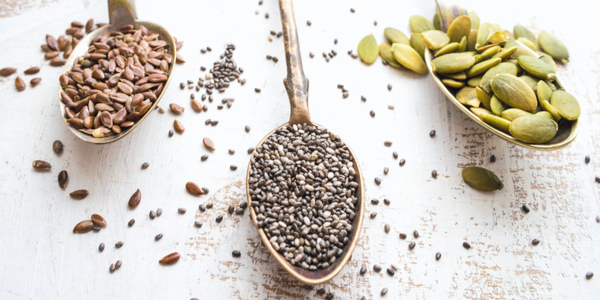
Plant a seed, watch it grow, harvest it, and begin the process again. Seeds go through their own seed rotation, but seed cycling is an entirely different dietary pattern.
What is seeding, and what is the seed diet? Read on for everything important on seed cycling, how to use seed rotation in a healthy diet, and even more!
What Is Seed Cycling?
Seed cycling, which is also sometimes called seed syncing, is a practice thought to improve hormonal balance. It is appropriate for women in many stages of life. Scientific studies are sparse, but dietitians and other experts explain that just because there are not studies doesn’t mean it won’t work.
A low-risk, natural method for coordinating hormone cycles, rotating seeds in the diet may be able to play a supporting role. Seeds are selected for certain cycles or patterns of eating based on their ability to balance hormones.
For example, flaxseed can prevent excess estrogen. Flaxseed contains dietary components related to a fiber called lignans, which bind to excess estrogen.
Seed Cycling for Hormones
There are many factors that influence the complex system of women's hormones. These include, but are not limited to, the following:
• Diet
• Exercise
• Sleep
• Stress levels
• Environmental toxins
When hormones become imbalanced, a number of health conditions can arise. These can include:
• Acne
• Polycystic ovary syndrome (PCOS)
• Thyroid disorders
• Irregular periods
• Chronic fatigue
What Does Seed Cycling Do?
The different seeds in seed cycling rotations have diverse effects on hormones in the body.
Flaxseed, as mentioned above, binds excess estrogen. Pumpkin seeds contain zinc, which helps to support the production of progesterone. Sunflower and sesame seeds also help give progesterone production a boost.
The following nutrients and food components help balance hormones during different phases of hormone production:
Reduce or Bind Excess Estrogen
• Lignans
• Selenium
Promote Progesterone Production
• Zinc
• Vitamin E
Benefit Hormonal Health
• Omega-3 fatty acids
• Omega-6 fatty acids
Is Seed Cycling Effective?
Seed cycling is regarded by dietitians as a generally low risk, easy, and gentle way to ease hormone balance.
Potential Health Benefits of Seed Cycling:
• Balances and stabilizes hormone levels
• Reduces premenstrual syndrome (PMS) symptoms
• Boosts fertility
• Stimulates menstruation if absent (amenorrhea)
Who Can Do Seed Cycling?
Women of any stage of life can use seed cycling for hormonal balance. Even post-menopausal women may benefit from the effects of seed cycling.
Particular populations that are looking to manage the following problems may find seed cycling particularly helpful:
• Post-birth control syndrome (or coming off hormonal birth control)
• Acne
• Irregular or missing periods
• PMS
What Is Seed Cycling For Fertility or Infertility?
Seed cycling is recommended to increase fertility. While there are no established studies that expose a direct link, seeds are packed with nutrients that contribute to balancing hormone levels.
Fertility depends on a variety of factors. Seed cycling may certainly help promote fertility but should not be the only measure taken on the path to pregnancy. A well-balanced diet is a key part, however, of creating stable hormone levels throughout the fertility process.
Is Seed Cycling Good for PCOS?
Experts say that seed cycling is not considered a cure-all. However, when it is incorporated consistently in a dietary pattern it can prompt healing. It is regarded as a simple and effective way to nourish and balance the body.
A good way to find out if seed cycling is right for an individual is to work with healthcare professionals. Hormone levels can be tested by working with a dietitian and doctor to reach a diagnosis or treatment plan.
Find a dietitian specialized in hormone optimization, women's health, or a related specialty that can help maintain a seed cycling plan.
How Seed Cycling Works
Seed cycling is a natural way to promote hormone balance. Tracking cycles and ovulation are a key part of syncing the correct seed rotations with each phase of the menstrual cycle.
For women who do not have a 28-day menstrual cycle or are experiencing life stages like menopause, a seed cycling or hormone specialist dietitian can help sync seed rotation to the right personal cycle times.
Keep in mind that seed cycling, like any dietary practice, takes time to work. Generally, it may take about three to six months to start seeing the benefits. Tracking or recording cycles, stages, symptoms, and shifts can be a great way to identify significant changes over time.
Understanding Seed Rotation
Seed rotation is done in accordance with specific phases of the menstrual cycle. The two main phases under normal hormone balance are as follows:
1. Follicular phase: The first 14 days of the menstrual cycle where estrogen levels rise
2. Luteal phase: The following 14 days of the menstrual cycle where progesterone levels rise while estrogen slowly declines
The balance between hormone levels of estrogen and progesterone is thought to be delicate. Slight changes or environmental factors (i.e. diet, exercise) may contribute to the following symptoms of imbalance:
• PMS
• Menstrual cramps
• Acne
• Short luteal phases
• Anovulation
• Irregular cycles
• Amenorrhea
How To Use Seed Cycling
Generally, dietitians recommend the following guidelines for seed cycling.
For days 1 to 14 of the menstrual cycle (menstruation to ovulation), or from new moon to full moon if experiencing amenorrhea, eat at least 1-2 tablespoons daily:
• Pumpkin seeds
• Flax seeds
For days 15-28 of the menstrual cycle (ovulation to menstruation), or from full moon to new moon if experiencing amenorrhea, eat at least 1-2 tablespoons daily:
• Sunflower seeds
• Sesame seeds
Successful seed rotation routines require that the eater prioritizes hormone balance. The following may be other issues that cause hormone imbalance and result in ineffective seed cycling:
• Digestive issues
• Blood sugar imbalances
• Stress
• Lack of proper nutrition
• Lack of sleep hygiene
• Environmental toxins (can be hormone-disrupting)
• Poor hydration
Typically, seed cycling is designed as one impactful factor that is part of an overall, holistic approach. In other words, it is just one piece in solving a hormone imbalance puzzle.
Creating a Healthy Seed Diet Cycle
Incorporating seeds into an eating routine can be done in multiple ways. There isn’t a "right" way, just the way that works best for the individual. Beyond women’s health, seeds contain plenty of fiber, vitamins, and minerals that support wellbeing.
Here are some ideas of dishes to add seeds to:
• Yogurt
• Smoothies
• Oatmeal
• Chia seed pudding
• Toast
• Bowls
• Salads
• Soups
• Pesto
• Homemade seed butter
• Homemade granola
• Energy or date balls
• Tahini (ground sesame paste)
Grinding seeds can also make them easier to digest. Raw seeds have almost all of their nutrients intact. Keeping seeds in the refrigerator or freezer also helps to maintain freshness and prevent damage to nutritional components.
The Bottom Line on Seed Cycling
Seed cycling, while not scientifically connected to benefits, is promoted by many nutrition experts for women's health. Seeds contain compounds that contribute to healthy hormone balance and optimize nutrition.
For women with PCOS, infertility, or uncomfortable menstrual or menopause symptoms, seed cycling can generally be a low-risk way to incorporate increased nutrient levels into the diet.
References:
Bippen J. Seed Cycling for Hormone Balance. Nourishedbynutrition.com. https://nourishedbynutrition.com/seed-cycling-for-hormone-balance/.
Carneglia E. What Is Seed Cycling. Nutritionstripped.com. Published February 7, 2020. https://nutritionstripped.com/what-is-seed-cycling/.
Composed Nutrition (Krista). What is Seed Cycling? Composednutrition.com. Published October 26, 2020. https://www.composednutrition.com/blog/what-is-seed-cycling.
Sharp A. Does Seed Cycling For Hormonal Balance Actually Work? Abbeyskitchen.com. Published July 29, 2020. https://www.abbeyskitchen.com/seed-cycling-for-hormonal-balance/.







